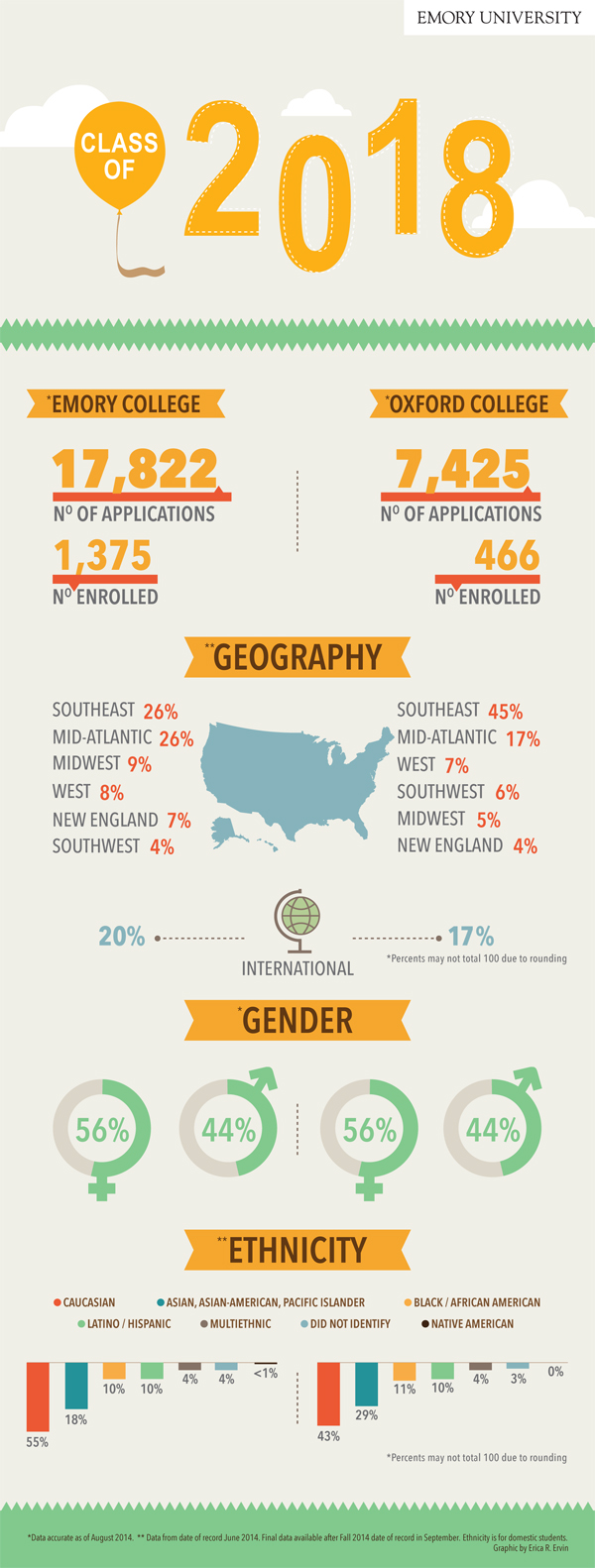Emory's Class of 2018 arrives with stellar test scores and grades, plus resumes brimming with community service, creative endeavors and athletic achievements. Representing about 1,840 first year students, the class was drawn from record application pools for Emory College (17,822) and Oxford College (7,425).
But selecting the Class of 2018 required looking beyond the metrics to find the students who are active learners and ready to soak up the knowledge and experiences that come with Emory's liberal arts-focused undergraduate education backed with research university resources.
"With such a healthy application pool, we're really able to shape a class and identify those students who are really engaged with their learning, who truly want an education with the breadth and depth in the liberal arts that Emory can offer," says John Latting, assistant vice provost for undergraduate enrollment and dean of admission.
That sentiment can be found in first-year student Dorcas Adedoja, a Gates Millennium Scholar from Philadelphia. "I honestly could not see myself anywhere else," Adedoja says. "Emory allows undergraduates to get their hands very dirty in terms of their areas of interest a lot earlier than most places, and I respected that."
The Emory College class hails from 45 countries, 48 states, Puerto Rico and Washington, D.C. (MIA: Montana and North Dakota). About 20 percent come from outside of the United States. A record number of students came to Emory through early decision: nearly half of the Emory College class and 35 percent at Oxford.
Ethnic diversity continues to move in a positive direction with about 22 percent of the Emory College class composed of African Americans, Latinos/Hispanic-identified students and other underrepresented minorities, Latting says. Overall, more than 42 percent identified as non-Caucasian in Emory College.
Their academic interests also reflect breadth and depth, and a growth in the arts and humanities. "We really think this class will populate all the corners of the university, from the courses they take, the extracurricular activities they engage with and the majors they will choose," Latting says.
Socio-economic diversity is reflected, too. About 10 percent of the applicants came through QuestBridge, a college recruitment and match program linking some of the nation's brightest under-served youth with leading institutions of higher education.
Students who come in through QuestBridge or other avenues are finding the resources they need. Emory remains committed to meeting 100 percent of demonstrated financial need for all admitted domestic students, including programs like Emory Advantage, which provides loan relief for families making less than $100,000.
About 58 percent of all Emory undergraduates receive financial aid with an average package of $40,239 for Emory College students. "We are opening up access to Emory and making a difference for those families for whom a college education is not the norm," Latting says.
Oxford College's record application pool also resulted in a greater diversification of the class and increased academic strength, says Kelley Lips, dean of enrollment services for Oxford. This year's freshman class is 17 percent international, and the majority (55 percent) are from outside of the Southeast and Georgia.
"Having such a distinctive first and second year experience helps prospective students understand the importance of fit, and encourages them to explore the two undergraduate entry points into Emory," Lips says. "You can sense the excitement of the class. They're eager to be a part of the Emory family, and ready to contribute to the community at Oxford."

